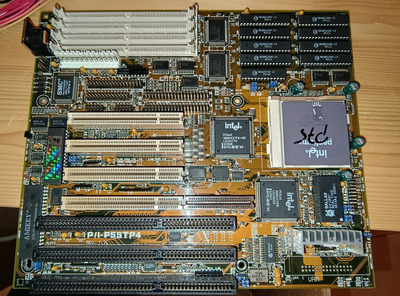First post, by IkeFox
I've tested this board below with different components, but all it does is a long, high-pitched beep (~2 sec. with a 2 sec pause, repeated indefinitely) when turned on.
According to several beep code lists for the Award BIOS, this indicates a RAM issue. Retroweb says this board takes FPM RAM: https://theretroweb.com/motherboards/s/asus-p-i-p55tp4
I tried 2 x 4 MB FPM modules (single-sided), 4 x 4 MB FPM (single-sided), 2 x 16 MB EDO (single-sided) and 2 x 32 MB EDO (double-sided), all with the same result.
Other components I used for testing are a Pentium-S 75 MHz, 2 PCI and 1 ISA graphics cards, and multiple ATX PSUs (with an adapter cable). All components have been tested and work fine with other boards.
FSB clock and clock multiplier have been double- and triple-checked (Note: the picture shows settings before configuring it for the Pentium-S 75). I also checked the only manual I could find, which is not exactly for this model but seems close enough (P55TP4XEG V2.1 and V2.4): https://www.manualslib.com/manual/434035/Asus … P-I-P55tp4.html The jumpers are in different locations but are numbered the same and the settings match the ones printed on the board.
Core voltage is set to 3.3 V from what I gathered from the manual. There are also jumpers for cache RAM voltage. Not sure what the difference between mixed voltage or 3.3 V cache RAM is, but I left the jumpers as they were, since I got the board with cache preinstalled.
I haven't tried changing the cache yet, but I'd be surprised if the BIOS can even detect an issue with cache RAM. Does anyone have an idea what else could be the problem, or is the board just broken?
